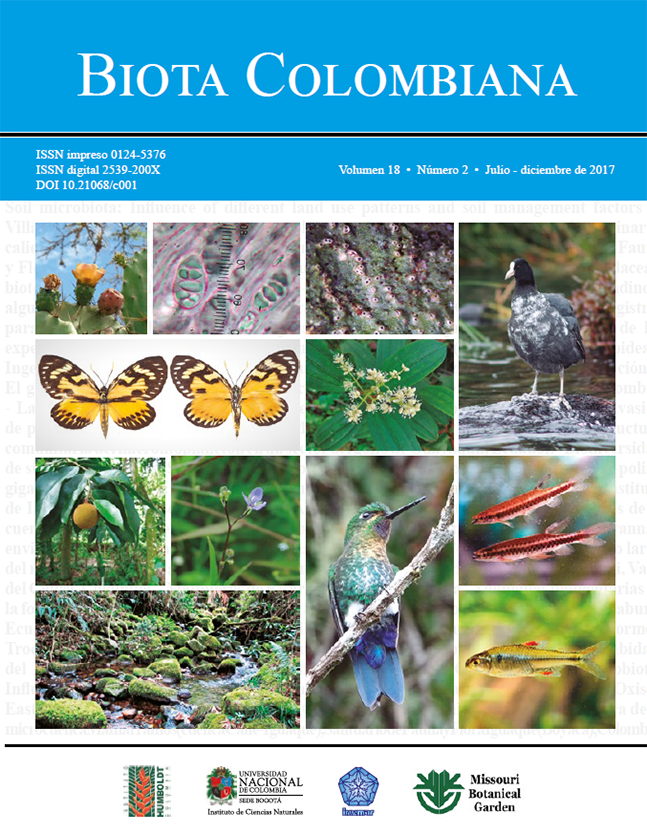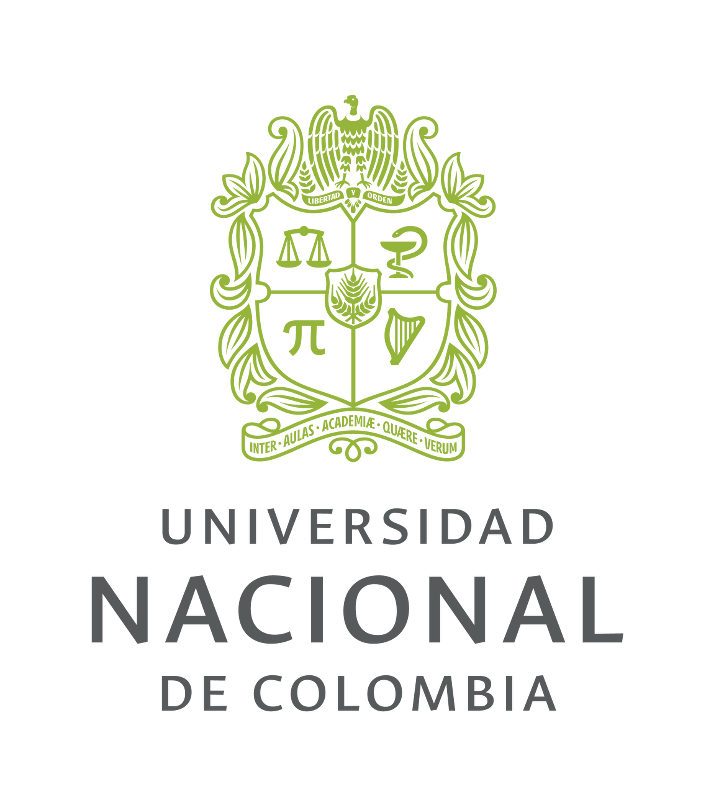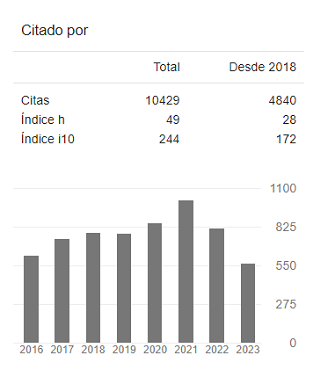Resumen (es):
Los escarabajos carábidos (Coleoptera: Carabidae) constituyen una importante porción de la diversidad de la fauna
edáfica. Dada su importancia en aspectos como el control natural de plagas y su respuesta como bioindicadores,
es importante reconocer los géneros y especies presentes en una determinada localidad, sin embargo, en Colombia
su estudio ha sido relativamente pobre. En el presente conjunto de datos se listan los géneros y algunas especies
de carábidos, depositados en el Museo de Entomología de la Universidad del Valle. Esta colección cuenta con
355 registros de 38 géneros, de los cuales sólo 10 tienen especímenes identificados a la categoría de especie.
Resumen (en):
Palabras clave:
Altitude, Colombia, Beetles, Specimen, Life zone (en)
Referencias
Arenas, A., I. Armbrecht y P. Chacón. 2013. Carábidos y hormigas del suelo en dos áreas cultivadas con maracuyá amarillo (Passiflora edulis) en el Valle del Cauca, Colombia. Acta Biológica Colombiana 18 (3): 439-448.
Arenas, A., G. Corredor e I. Armbrecht. 2015. Hormigas y carábidos del suelo en cuatro ambientes del piedemonte del Parque Nacional Natural Farallones de Cali, Colombia. Revista Colombiana de Entomología 41 (1): 120-125.
Arndt, E. y S. Kirmse. 2002. Adaptation to seed-feeding in ground beetles (Coleoptera: Carabidae: Harpalini) of South Venezuela. Studies on Neotropical Fauna and Environment 37 (2): 151-157.
Ball, G. E. y D. R. Maddison. 1987. Classification and evolutionary aspects of the species of the New World genus Amblygnathus Dejean, with description of Platymetopsis, new genus, and notes about selected species of Selenophorus Dejean (Coleoptera: Carabidae: Harpalini). Transactions of the American Entomological Society 113 (3): 189-307.
Camero, E. 2003. Caracterización de la fauna de carábidos (Coleoptera: Carabidae) en un perfil altitudinal de la Sierra Nevada de Santa Marta, Colombia. Revista Academia Colombiana de Ciencias 27 (105): 491-516.
Cassola, F. y D. L. Pearson. 2001. Neotropical tiger beetles (Coleoptera: Cicindelidae): checklist and biogeography. Biota Colombiana 2 (1): 3-24.
Erwin, T. L., C. Micheli y G. Hevel. 2012. The Beetle Family Carabidae of Guyane (French Guyana): the Tribes, Genera, and number of species known, with notes on their ways of life. (Insecta: Coleoptera: Adephaga). Bulletin Le Coleopteriste 5: 1-88.
Erwin, T. L. 1965. A revision of Brachinus of North America: Part I. The California species (Coleoptera: Carabidae). The Coleopterists Bulletin 19 (1): 1-19.
Erwin, T. L. 2011. Rainforest understory beetles of the Neotropics, Mizotrechus Bates 1872, a generic synopsis with descriptions of new species from Central America and northern South America (Coleoptera, Carabidae, Perigonini). ZooKeys 145: 79-128.
Erwin, T. L. y L. S. Zamorano. 2014. A synopsis of the tribe lachnophorini, with a new genus of neotropical distribution and a revision of the neotropical genus Asklepia Liebke, 1938 (Insecta, Coleoptera, Carabidae). ZooKeys 430: 1-108.
Gidaspow, T. 1963. The genus Calosoma in Central America, The Antilles, and South America (Coleoptera, Carabidae). Bulletin of the American Museum of Natural History 124: 275-314.
Grimaldi, D. y M. S. Engel. 2005. Evolution of the insects. Cambridge University Press. 755 pp.
Lundgren, J. G. 2009. Relationships of Natural Enemies and Non- Prey Foods. Springer Science + Business Media B.V. Brookings, SD., 453 pp.
Martínez, C. 2005. Introducción a los Escarabajos Carabidae (Coleoptera) de Colombia. Instituto de Investigación de Recursos Biológicos Alexander von Humboldt. Bogotá D.C., 546 pp.
Martínez, C. y G. E. Ball. 2003. Los Platynini (Coleoptera: Carabidae) de Colombia. Biota Colombiana 4 (2): 175-186.
Mateu, J. 1991. Sur le genre Oxytrechus Jeannel, 1927, avec la description de nouvelles especes de l’Equateur et de la Colombie (Coleoptera, Carabidae, Trechinae). EOS 67: 71.83.
Nisensohn, L., D. Faccini, G. Montero y M. Lietti. 1999. Predación de semillas de Amaranthus quitensis H.B.K. en un cultivo de soja: influencia del sistema de siembra. Pesquisa Agropecuária Brasileira 34 (3): 377-384.
Pardo-Locarno, L. C. y M. Puerta-Paz. 1990. Contribución al registro taxonómico y ecología de las familias de Coleoptera (Insecta) de la zona plana del Valle del Cauca-Colombia. Cespedesia 59(16-17): 7-30.
Pardo-Locarno, L. C., M. Puerta-Paz y J. I. Pulido. 1991. Coleópteros de la zona plana del Valle del Cauca: registros taxonómicos, observaciones ecológicas y económicas generales. Agricultura Tropical 28 (3): 93-108.
Pearce, J. L. y L. A. Venier. 2006. The use of ground beetles (Coleoptera: Carabidae) and spiders (Araneae) as bioindicators of sustainable forest management: A review. Ecological Indicators 6: 780-793.
Rainio, J. y J. Niemela. 2003. Ground beetles (Coleoptera : Carabidae) as bioindicators. Biodiversity and Conservation 12: 487-506.
Ramírez Mora, M. A. 2008. Escarabajos tigre (Coleoptera: Cicindelidae) del Museo entomológico Francisco Luis Gallego: nuevos registros para departamentos de Colombia. Revista Facultad Nacional de Agricultura, Medellín 61 (1): 4302-4315.
Reichardt, H. 1967. A monographic revision of the american Galeritini (Coleoptera, Carabidae). Arquivos de Zoologia 15 (1-2): 1-176.
Straneo, S. 1991. South American species of Loxandrus LeConte, 1852 (Coleoptera: Carabidae: Pterostichini). Annals of Carnegie Museum 60 (1): 1-62.
Sunderland, K. D. 2002. Invertebrate Pest Control by Carabids. pp. 165–214. En: Holland, J. M. (Ed). The Agroecology of Carabid Beetles. Andover, Hampshire.
Torres Domínguez, D. M. y J. A. Mendivil Nieto. 2012. Escarabajos tigre (Coleoptera: Carabidae: Cicindelinae) del PNN Gorgona, Cauca, Colombia. Boletín del Museo de Entomología de la Universidad del Valle 13 (2): 20-25.
Uribe L., M. y L.F. Vallejo E. 2013. Diversidad de escarabajos Carabidae y Scarabaeidae de un bosque tropical en el Magdalena medio colombiano. Boletín Científico Centro de Museos 17 (2): 174-196.
White, W. H., T. L. Erwin y B. J. Viator. 2012. Leptotrachelus dorsalis (Coleoptera: Carabidae): A Candidate Biological Control Agent of the Sugarcane Borer in Louisiana. Florida Entomologist 95 (2): 261-267.
Yábar, E., E. Castro, L. Meló y E. Gianoli. 2006. Predación de Bembidion sp., Notiobia peruviana (Dejean) y Metius (Coleoptera: Carabidae) sobre huevos de Premnotrypes latithorax (Pierce) (Coleoptera: Curculionidae) en condiciones de laboratorio. Revista Peruana de Entomología 45: 91-94.
Cómo citar
Las obras publicadas en las revistas del Instituto de Investigación de Recursos Biológicos Alexander von Humboldt están sujetas a los siguientes términos, con relación al derecho de autor:
1. Los derechos patrimoniales de las obras publicadas tienen como titular al Instituto de Investigación de Recursos Biológicos Alexander von Humboldt. Los autores o las instituciones que elaboran el documento aceptan ceder los derechos patrimoniales al Instituto Humboldt con el envío de sus artículos, lo que permite –entre otras cosas– la reproducción, comunicación pública, difusión y divulgación de las obras.
2. Las obras de ediciones digitales se publican bajo una licencia de Creative Commons Colombia:
Esta obra está bajo una Licencia Creative Commons Atribución-NoComercial-SinDerivar 4.0 Internacional.
Atribución – No comercial – Sin Derivar: Esta licencia es la más restrictiva de las seis licencias principales, sólo permite que otros puedan descargar las obras y compartirlas con otras personas, siempre que se reconozca su autoría, pero no se pueden cambiar de ninguna manera ni se pueden utilizar comercialmente.
3. Los autores, al someter artículos al proceso editorial de las revistas editadas por el Instituto Humboldt, aceptan las disposiciones institucionales sobre derechos de autor y acceso abierto.
4. Todos los artículos recibidos serán sometidos a un software antiplagio. El sometimiento de un artículo a las revistas del Instituto Humboldt se entiende como la aceptación de la revisión para detectar posible plagio.
5. Las obras sometidas al proceso de edición de las revistas del Instituto Humboldt deben ser inéditas.


















